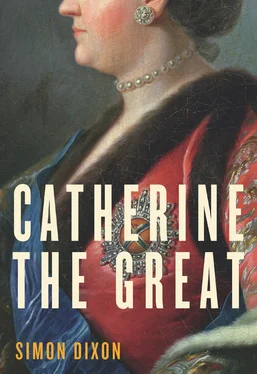While the populace made ready to greet their sovereign, Catherine was doing her homework about the provinces. To prepare her for the journey, the Academy of Sciences drew up a short Geographical Description of the River Volga , which also allowed her to chart her progress once the cruise had begun. Great care was taken to ensure the accuracy of this attractive publication, whose first edition was pulped when it turned out to contain significant errors. Dividing the course of the river into sections, it illustrated each one with an engraved map accompanied by four readily referenced columns of text. Here Catherine could look up lists of the churches and principal economic activity of the towns along the route, the distances travelled from Tver, the distances between tributaries (faithfully marked on each bank of the Volga), and the position and direction of bends in the river. Full of the sorts of detail the empress admired, this pamphlet gave a good sense of the variety in store for her along the way. For example, whereas Nizhny Novgorod, at the confluence of the Volga and the Oka, could boast thirty-nine churches, four cathedrals, three monasteries, two convents and a trade in grain and handicrafts, there was but a single church at Kokshaisk, the last sizeable settlement before the old Tatar capital at Kazan, where ‘the inhabitants feed themselves entirely from agriculture and cattle-breeding’. 12
Catherine made her final preparations for the journey in Moscow, chosen as the seat of the Legislative Commission in memory of the ad hoc gatherings, later known as Assemblies of the Land, at which the Muscovite tsars had ritually consulted their leading subjects. 13‘I prefer Petersburg,’ she admitted, rehearsing all her frustrations with the unruly old capital that seemed to represent ‘a nasty autumn’ by comparison with the new one’s ‘onset of spring’. 14If her palace was lacking in comfort, she had only herself to blame. ‘The Construction Chancellery has asked me for more than 60,000 roubles for repairing and cleaning the Golovin and Kremlin palaces,’ she had complained to the Governor General the previous summer. ‘And most of it, as you will see, is purely for decoration and furniture. But since I am going to Moscow not for magnificence but for the good of the state, I have not the slightest need for luxury.’ In the end, in one of her first clear rejections of Baroque extravagance, she spent only 7000 roubles on safety measures at the Golovin Palace, where she arrived on 13 February to celebrate the beginning of Lent with typically irreverent gusto. 15As she explained to the French sculptor Etienne-Maurice Falconet:
I read yesterday in the Encyclopédie article on ‘religious orders’ that your king, Saint Louis, said that if he could divide himself in two, he would do so, and give one half to the Dominicans and the other to the Franciscans. You can see that this good king would not have much left of his kingdom. Good king is the wrong expression: I should have said good man , for a good man can tell such stories, whereas a good king does better to keep his kingdom intact, and not to divide it among mendicant monks. 16
Lent nevertheless had its uses. It gave her an excuse to keep out of the public eye until she had taken the political temperature of a city where she had delayed elections for the Legislative Commission until after her arrival. Occasional Court reception days were held during the Great Fast, shorn of the customary musical accompaniment, and Catherine celebrated the feast of the Annunciation with her cavalry officers. Otherwise, Moscow saw little of its empress until 5 April, when she travelled in state to the Kremlin to take her annual communion at the Cathedral of the Dormition and watch as Archbishop Dimitry performed the Maundy Thursday ritual of the washing of the feet. That weekend, cannon salutes signalled the progress of her nocturnal drives back and forth across the city for the Easter vigil services. 17Alarmed by the decrepitude of all three Kremlin cathedrals, Catherine ordered Field Marshal Saltykov to call a meeting of all the city’s architects to decide how to make them safe. ‘PS There’s no time to lose with the Archangel cathedral.’ 18
On 21 April, the atmosphere was once again more intimate, as the empress celebrated her thirty-eighth birthday at the little wooden palace at Taininskoye in the company of Alexander Stroganov and other friends. 19She did not attend the public lecture given two days later at Moscow University by Professor Johann Schaden, who looked forward to the Legislative Commission by discoursing ‘On the Spirit of the Laws’. 20By then, she was almost ready to depart for the Volga. On the evening of 29 April, Fermor and Ivan Chernyshëv were on hand to greet her at Tver with the usual barrage of fireworks. ‘We are all well,’ she reported to Panin, who had remained in Moscow with his mistress and Grand Duke Paul: ‘the journey was average, the weather very good.’ 21
It stayed fine for the next two days, as Catherine was treated to the sorts of gala reception that were to be repeated again and again over the coming weeks: whole regiments stood on parade, awaiting her inspection; nobles and merchants queued to offer her hospitality; seminarians dressed all in white chanted Russian and Latin verses written expressly for the occasion; hundreds of subjects were permitted to kiss her hand. Braving the cold on 1 May, she spent a couple of hours with Archbishop Gavriil (Petrov) in the garden of his new cathedral. Only after that did the clouds burst. But since the following day was mid-Pentecost, the empress and her suite processed through the rain for almost a mile to a sanctification service at a Jordan on the Volga. Once Grigory Orlov had passed her the customary glass of holy water, they returned to the cathedral where Gavriil had given ‘a very good sermon’ earlier that morning, and the empress lunched with him before finally boarding her galley, the Tver . Thousands thronged the streets in the hope of catching a glimpse of the procession of the cross and Catherine declared it ‘impossible to count the people and carriages’ blocking the route as she made her way to the quayside. Some women in the crowd rowed out to the Tver , at anchor in the river, while other cheering well-wishers sailed in her wake or scampered along the riverbank as the colourful flotilla at last set sail at three in the afternoon. 22
By seven the following evening, Catherine had reached Prince Dolgoruky’s estate almost sixty miles downstream. The rain had stopped, she had plenty of good company—among others, she shared the Tver with Grigory and Vladimir Orlov, the Chernyshëv brothers and Alexander Bibikov, the man she was grooming to be Marshal of the Legislative Commission—and she was relieved to report that they had all stayed well, despite the weather. It remained changeable as they sailed on to the Makaryev monastery on 5 May. ‘Small but handsome’, in Vladimir Orlov’s words, this ancient house had once owned more than 60,000 peasants in a single provincial district. Since it also marked the boundary of Gavriil’s diocese, it was here that she took leave of her favourite prelate. Local boatmen rowed alongside for several miles, accompanying Catherine with their melancholy songs as she departed for Uglich, where Ivan the Terrible’s son, the tsarevich Dimitry, had died from stab wounds in 1591. Both Pushkin and Musorgsky later dramatised the event in a version alleging (almost certainly wrongly) that Boris Godunov had brought destruction upon himself by ordering the assassination of a prince who blocked his own path to the throne. In the light of Peter III’s fate, this was one aspect of the Muscovite legacy that no one wanted to highlight in 1767. Catherine cruised on regardless. ‘It’s very jolly to sail on the water,’ she told her own son, adding disingenuously: ‘I’m sorry only that you are not with me.’ 23
Читать дальше












